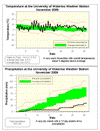This fall really showed that you can’t take what happens during the first month and extrapolate it to the rest of the season. Up to mid-October it was very cold and very wet, however since then it has turned around.
For temperature, November was quite a bit warmer than average and the beginning of December was moderately warmer making the overall season a full degree above average.
The most surprising thing about the temperature was that the lowest we saw was only -11.9 °C, where we often see it dip down approaching -20 °C or below during the season. This was the highest low temperature of the season since 2001 when it only got down to -8.6 °C.
Looking at precipitation, it really dried out after that wet start and the final total (218.3 mm) was very close to the average (220.9 mm). Of course everybody wants to know about the snow, and in this regard the total for the season (25 cm) was a lot less than last year (96 cm) and the average for fall (40 cm).
Summary for Fall 2009:
Maximum Temperature 24.1 °C
Minimum Temperature -11.9 °C
Average Daily High Temperature 8.8 °C (Long term average 8.3 °C)
Average Daily Low Temperature 1.0 °C (Long term average -0.5 °C)
Total Precipitation 218.3 mm (Long term average 220.9 mm)
(Long term averages based on 1970-2000 data for the Waterloo Wellington Airport)

Sign up to get the monthly weather station summary by e-mail



